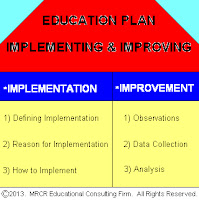Education Plan Evaluation
Author: Manuel R. CortezRodas
An education plan is a good and useful tool that educators should create, obtain, and learn to use. This education tool, as with any other, has to be evaluated. To evaluate an education plan one must be able to demonstrate that the plan clearly identifies the following three areas: What is the goal of the plan? How is the success of the plan measured? Why is the result of the plan created? An approach on how to address these three areas is presented next.
What is the goal of the plan?
Every student will be educated, and be able, to successfully demonstrate, that they have become educated. This is but one example of a goal in an education plan, the goal you will set for your education plan may be different, but it must be stated clearly. Establish, with clarity, what the goal for your education plan is.
How is success measured?
Success is measured, by results accumulated over time, which are then compared, to an established measurement, which has been determined to be acceptable. It will take time to measure success, and it will take time to evaluate the measure of success that has been established for the education plan.
Why is the result created?
The result of executing an education plan, can be affected by a multitude of variables, some which are beyond any control, but should be evaluated, so the plan may be implemented, improved, and executed, to further benefit those who are being educated.
To evaluate an education plan, one should be able to clearly state the goal of the plan, the measure of the success for the plan, and why the plan created such results. Evaluating an education plan is an important step in the overall creation of the plan by the educator. We must evaluate the plan if we are to know if the plan succeeded, and if it did not, then learn from the evaluation on how we best can improve the implementation of the plan for future execution.
Copyright 2013. MRCR Educational Consulting Firm. All Rights Reserved.







